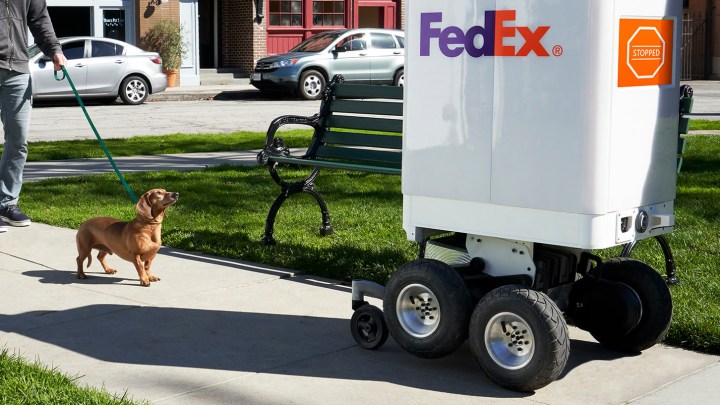
Gaggles of delivery R2D2’s scurrying down suburban streets? It sounds like a technological nightmare worse than an e-scooter infestation. But the concept of robot messengers got a major boost recently when FedEx announced plans to start testing such a service this summer, and for smart cities, it may not be such a crazy idea after all.
There are already several pilot robo-delivery projects running in the U.S.
Cities across the globe are installing technology to gather data in the hopes of saving money, becoming cleaner, reducing traffic, and improving urban life. In Digital Trends’ Smart Cities series, we’ll examine how smart cities deal with everything from energy management, to disaster preparedness, to public safety, and what it all means for you.
Nuro, for example, recently announced it’s moving on from Arizona and expanding its delivery partnership with grocery giant Kroger to four Houston zip codes. Nuro’s vehicle is more of autonomous compact car than a rolling robot, but so far people seem happy to pay the roughly $6 for the self-driving silver surfer (probably because they don’t have to tip the car).
The 7,000-pound gorilla in retail, Amazon, is reportedly testing a sidewalk-crawling delivery bot in Seattle. The project looks like a more practical service for suburbs — especially compared to drones, which are restricted or outright banned in many urban areas.

Most recently, FedEx has announced that it plans to begin testing its own autonomous delivery robot in Memphis, Tennessee. And while there are other delivery bot tests underway in addition to the ones mentioned, the entrance by the preeminent delivery service in the U.S. into the self-driving space represents something of a milestone.
Hitting the streets sidewalks
FedEx isn’t talking about autonomous vans and trucks — at least not yet. And the challenges facing even mainly on-the-sidewalk robots are legion. Weather, uneven terrain, traffic, poor cellular network coverage, and humans behaving badly are just a few of the headaches facing programmers. However, FedEx’s partners and its own delivery infrastructure imply that it may be uniquely positioned to overcome those obstacles.
The delivery bots, for example, are designed in partnership with Dean Kamen’s DEKA Development & Research Corp. Kamen is best known for developing the Segway and the iBot Personal Mobility Device, a wheelchair that can climb stairs. The latter demonstrates that DEKA’s engineering skills will probably be able to help FedEx surmount some of the navigation issues for door-to-door delivery. Indeed, the fully electric FedEx SameDay Bot is based on the iBot, with some additional technology that makes it autonomous, including lidar, radar, and video cameras to assist in navigation.
According to Kamen, the SameDay bot can run at about 10 miles per hour, “which won’t disturb pedestrians.” Kamen made the remarks during a presentation to announce the new partnership. The inventor said the SameDay Bot’s speed limiter means it won’t cause the kinds of problems associated with cyclists and messengers who hop onto sidewalks — but it will still be able to handle round trips of up to eight miles relatively quickly.
The road ahead
FedEx plans to work with retailers including AutoZone, Lowe’s, Pizza Hut, Target, Walgreens, and Walmart to perform, as its robot’s name implies, same-day door-to-door deliveries. Customers can open the bot using a smartphone app, or have it opened by a remote operator. Those operators will also control the bots should the machines encounter situations they don’t recognize.

“It’s a way they could take on Amazon,” Gary Goralnick, a shopping center developer, told Digital Trends regarding self-driving technology. Goralnick said integrating online ordering and same-day delivery, for example, has helped brick and mortar retailers turn the corner and compete against Internet-only outlets.
Still, others note that such self-driving solutions beg for an infrastructure solution.
“You have to redesign the city before you layer in the technology,” Duncan Davidson, a technology investor with Bullpen Capital, told Digital Trends. Davidson pointed to examples such as e-scooters causing problems in Los Angeles and Uber cars causing additional congestion in New York City as ways in which technology can wreak havoc in cities — unless it’s supported by the right infrastructure changes.
None of these robo-delivery services will work unless consumers embrace the concept
Autonomous cars and delivery vehicles, for example, may need their own dedicated lanes. Making such changes could improve safety and help reduce traffic. And there are many ways in which same-day delivery in underserved areas could help home-bound individuals who suffer from chronic illnesses or other restrictions that prevent them from getting outside.
Indeed, Hyundai has a program called Elevate to develop an autonomous vehicle that can navigate rough terrain and even climb stairs to reach customers. And Dean Kamen’s iBot was originally designed to help people such as disabled veterans get around on their own. (The partnership with FedEx should help make the iBots more affordable for those who need them, according to Kamen.)
Ultimately, none of these robo-delivery services will work unless consumers embrace the concept. As long as they steer clear of scary robots, like Boston Dynamics’ headless Spot Mini, and focus on friendly delivery devices that look like R2D2, it may just work out.



